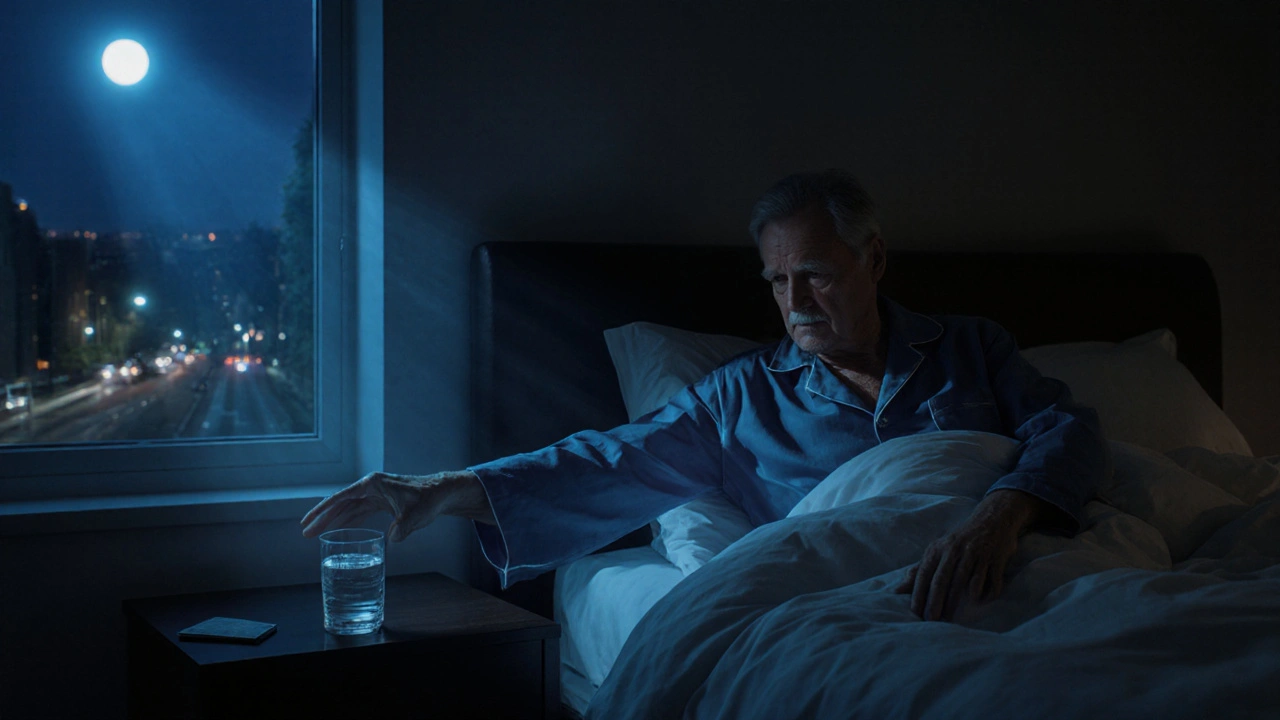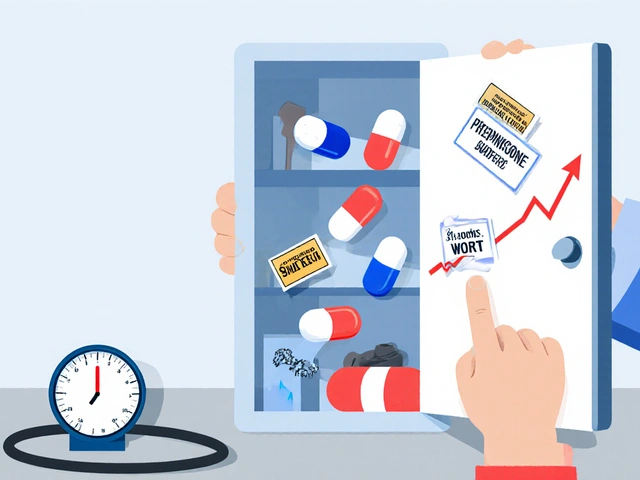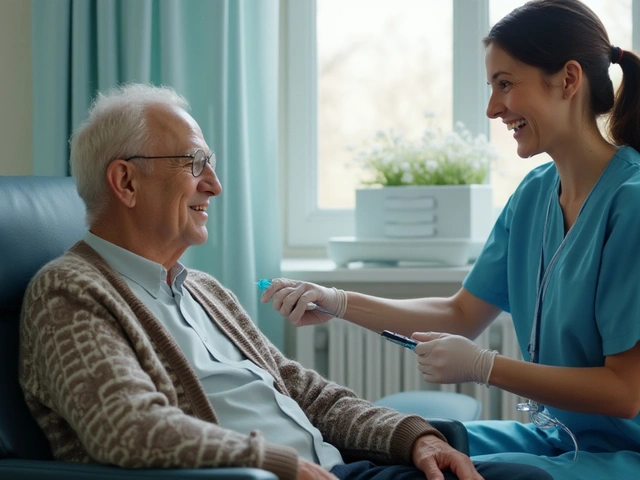
TL;DR
- Alcohol acts as a diuretic and suppresses the hormone that tells your kidneys to hold water, making you pee more often.
- Higher blood‑alcohol levels relax the bladder’s detrusor muscle, reducing its ability to store urine.
- People with weak pelvic floor muscles or pre‑existing bladder issues are most at risk for leakage after drinking.
- Limiting intake, staying hydrated with water, and doing pelvic‑floor exercises can lower the chance of episodes.
- Seek medical advice if leakage becomes frequent, painful, or interferes with daily life.
When you pour a drink, Alcohol Consumption is the intake of ethanol‑containing beverages such as beer, wine, or spirits triggers a cascade that can lead to urine leakage, also known as urinary incontinence. The link isn’t just a coincidence - it’s rooted in how alcohol interacts with the kidneys, bladder, and nervous system. Below we break down the biology, the risk factors, and practical steps you can take to keep a dry night after a night out.
How Alcohol Messes with Your Bladder
Three key mechanisms turn a casual drink into a bathroom sprint:
- Diuretic effect: Alcohol inhibits antidiuretic hormone (ADH), also called vasopressin. ADH normally tells the kidneys to re‑absorb water. When ADH is suppressed, the kidneys dump more fluid into the urine, increasing volume and frequency.
- Detrusor muscle relaxation: The detrusor muscle the smooth muscle that contracts to empty the bladder becomes less responsive at higher blood‑alcohol concentrations. This means the bladder can’t contract efficiently, and the urge to void may be delayed or feel sudden.
- Nervous‑system interference: Alcohol depresses the central nervous system, reducing the brain’s ability to sense a full bladder. The result is a lag between feeling the need to go and actually acting on it, which can cause overflow and leakage.
Types of Urine Leakage Affected by Drinking
Not all leakage is the same. Alcohol tends to exacerbate certain forms more than others. The table below highlights the most common types and how alcohol influences each.
| Incontinence Type | Typical Trigger | Alcohol’s Role |
|---|---|---|
| Stress Incontinence | Sudden pressure (coughing, sneezing) | Relaxed pelvic floor muscles make the urethra less supportive, turning minor pressure into leakage. |
| Urge (Overactive Bladder) Incontinence | Strong, sudden urge to void | Increased urine volume + delayed signal amplification leads to frantic urgency. |
| Overflow Incontinence | Bladder can’t empty fully | Detrusor dysfunction combined with excess fluid overloads the bladder, causing constant dribbling. |
| Functional Incontinence | d>Physical or cognitive barriers to reaching bathroomAlcohol‑induced confusion or impaired mobility makes it harder to get to the toilet in time. |
Who’s Most Vulnerable?
While anyone can experience a leaky moment after a few drinks, certain groups face higher odds:
- Women - especially those who have given birth, because pregnancy stretches the pelvic floor.
- Older adults - aging reduces bladder capacity and muscle tone.
- People with diabetes - nerve damage (neuropathy) already hampers bladder signaling.
- Those on diuretic medications - the combined fluid loss can overwhelm the bladder.
- Heavy drinkers - regular high‑BAC levels keep ADH suppressed chronically, weakening bladder control over time.
Understanding these risk factors helps you decide whether to cut back, seek treatment, or simply plan bathroom breaks during a night out.

Practical Steps to Keep the Leak at Bay
Here’s a straightforward action plan you can follow before, during, and after drinking:
- Hydrate with water: For every alcoholic drink, sip a half‑glass of water. This dilutes the alcohol, helps the kidneys maintain some ADH activity, and reduces overall fluid load.
- Choose lower‑alcohol options: A light beer (4%ABV) or a glass of wine (12%ABV) puts less stress on the bladder than spirits (40%ABV).
- Plan bathroom breaks: Set a timer every 60-90 minutes. Even if you don’t feel the urge, a quick trip empties the bladder before it becomes overstretched.
- Strengthen pelvic floor muscles: Do Kegel exercises daily - contract the muscles you’d use to stop urine mid‑stream, hold for five seconds, relax, and repeat 10-15 times.
- Avoid carbonated mixers: Bubbles increase gastric pressure, which can push on the bladder and trigger urgency.
- Watch medication interactions: Talk to your pharmacist if you take diuretics, antihistamines, or antidepressants, as they can magnify alcohol’s diuretic effect.
When to Seek Professional Help
Occasional leakage after a night of drinks isn’t usually a red flag, but you should book an appointment if you notice any of the following:
- Leakage occurs more than twice a week, even when sober.
- Painful burning, blood in urine, or fever - signs of infection.
- Difficulty starting or stopping urine flow.
- Sudden loss of bladder control after a minor amount of alcohol.
Doctors may run a urinalysis, bladder stress test, or refer you to a pelvic‑floor physiotherapist. Early intervention can prevent long‑term damage and improve quality of life.
Bottom Line
Alcohol+urine leakage isn’t magic - it’s science. The diuretic kick, muscle relaxation, and nervous‑system slowdown all conspire to make the bladder less reliable. By moderating intake, staying hydrated, and keeping the pelvic floor strong, you can enjoy a drink without the dread of an unexpected puddle. If the problem persists, a health professional can pinpoint the exact cause and chart a treatment plan.
Frequently Asked Questions
Does any amount of alcohol cause leakage?
Small amounts may not trigger leakage in healthy adults, but even one or two drinks can increase urine output enough to cause urgency, especially if you’re already prone to overactive bladder.
Can I drink beer without risking incontinence?
Yes, if you keep the beer low‑alcohol, stay hydrated with water, and empty your bladder regularly. The key is moderation and planning.
Are there specific foods that help prevent leakage after drinking?
Foods rich in potassium (bananas, sweet potatoes) support normal muscle function, and those high in fiber reduce constipation, which otherwise puts pressure on the bladder.
Is caffeine or alcohol worse for the bladder?
Both are diuretics, but alcohol also impairs the nervous system’s signal to the bladder, making it a stronger trigger for leakage than caffeine alone.
Can pelvic‑floor physiotherapy cure alcohol‑related leakage?
Physiotherapy can greatly improve muscle tone, reducing the severity of stress and urge leakage. It won’t stop the diuretic effect of alcohol, but it gives you a stronger bladder reserve to handle the extra fluid.
5 Comments
Quinn Comprosky
October 9, 2025 AT 07:39 AM
I completely understand how unsettling it can feel when a simple night out turns into a frantic dash for the bathroom and suddenly you’re dealing with unexpected leakage that makes you question your own body’s reliability and it’s especially hard when you’re already juggling work stress family obligations and the ever‑present pressure to appear in control so I want to say that you’re not alone in this experience many people report similar episodes and the good news is that there are practical steps you can take that don’t require a complete overhaul of your lifestyle but rather a few mindful adjustments that can make a noticeable difference over time, for example setting a personal reminder to sip water between drinks and taking a few minutes each day to perform pelvic floor contractions can gradually strengthen the muscles that keep the bladder sealed even when alcohol is present
Dan Tenaguillo Gil
October 20, 2025 AT 07:32 AM
First, let’s acknowledge that alcohol’s effect on urinary function is multifactorial, involving hormonal suppression, muscle relaxation, and neural inhibition, each of which contributes to a higher risk of leakage in susceptible individuals. Second, it is important to identify personal risk factors such as gender, age, prior pelvic surgeries, and comorbid conditions like diabetes, because these variables determine how strongly your bladder will react to ethanol. Third, consider keeping a simple log for a fortnight, noting each alcoholic beverage, its volume, and any episodes of urgency or dribbling, as this data will help you see patterns that might otherwise be invisible. Fourth, use the log to experiment with lower‑alcohol options; swapping a 12‑ounce beer for a light version can reduce the diuretic load by up to thirty percent, which often translates into fewer bathroom trips. Fifth, hydrate strategically by drinking a half‑glass of water after each alcoholic drink; this not only offsets dehydration but also encourages a more gradual urinary output. Sixth, schedule bathroom breaks proactively, ideally every sixty minutes, regardless of sensation, to prevent over‑distension of the bladder. Seventh, integrate pelvic‑floor strengthening exercises into your daily routine; a series of ten slow Kegels performed three times a day can, over several weeks, increase urethral closure pressure noticeably. Eighth, learn the proper technique for Kegels: imagine stopping the flow of urine mid‑stream, contract the innermost muscles, hold for five seconds, then relax completely, and repeat without recruiting abdominal or gluteal muscles. Ninth, if you find it difficult to isolate the correct muscles, consider consulting a pelvic‑floor physiotherapist who can provide biofeedback and tailored progression plans. Tenth, be mindful of other diuretic agents such as caffeine and certain medications; combining these with alcohol can exacerbate the problem. Eleventh, avoid carbonated mixers because the bubbling pressure can transmit to the bladder, heightening urgency. Twelfth, maintain a balanced diet rich in potassium and magnesium, as these electrolytes support smooth muscle function throughout the urinary tract. Thirteenth, watch for signs that go beyond occasional leakage, such as pain, blood in urine, or infections, and seek medical evaluation promptly. Fourteenth, remember that occasional leakage after heavy drinking does not equate to a chronic condition, but persistent symptoms merit a thorough work‑up that may include urodynamic testing. Fifteenth, stay patient with yourself, as building bladder resilience is a gradual process that may take several weeks of consistent practice. Finally, celebrate small victories-whether it’s making it through a social event without an emergency or noticing a reduction in bathroom trips-as these reinforce positive behavior and motivate continued adherence to the plan.
Tiffany Owen-Ray
October 31, 2025 AT 07:26 AM
Think of the bladder as a reservoir that reflects the balance between desire and restraint, a microcosm of how we navigate pleasure and responsibility in life; when we indulge without mindfulness, the container overflows, reminding us that every choice carries a ripple effect. As a coach, I encourage you to view each drink as a data point, each bathroom break as a checkpoint, and each pelvic‑floor contraction as a small act of self‑ownership that, cumulatively, builds a stronger sense of agency over your body.
Jill Brock
November 11, 2025 AT 07:19 AM
Wow, just drank a cocktail and now I’m leaking like a busted pipe!






Christian Miller
September 28, 2025 AT 07:46 AM
It is worth noting that the pharmaceutical industry, in collusion with regulatory agencies, has long downplayed the true impact of ethanol on urological health, thereby ensuring that the public remains unaware of the systematic destabilisation of the bladder that occurs with regular consumption of distilled spirits. The suppression of research data regarding the diuretic and muscular‑relaxant properties of alcohol is a calculated strategy aimed at maintaining market dominance, rather than a benign oversight. Consequently, the guidance you find in mainstream articles often omits the subtle yet profound neuromodulatory effects that alcohol exerts on antidiuretic hormone pathways, which can predispose individuals to chronic urinary leakage.